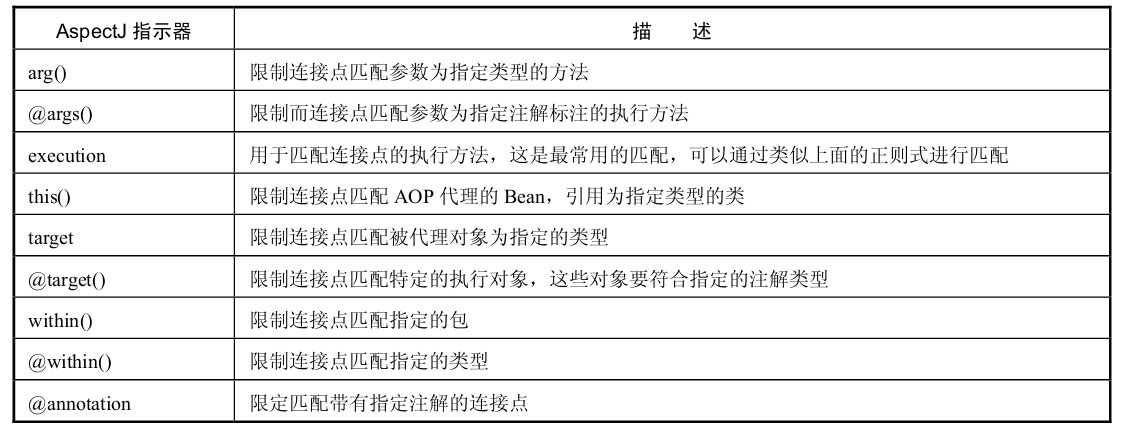选择切点
Spring是方法级别的AOP框架,而我们主要也是以某个类的某个方法作为切点,用动态代理的理论来说,就是要拦截哪个方法织入对应AOP通知。
代码清单:打印角色接口
代码清单:打印角色接口
package com.ssm.chapter11.aop.service; import com.ssm.chapter11.game.pojo.Role; public interface RoleService { // public void printRole(Role role); public void printRole(Role role, int sort); }
代码清单:RoleService实现类
package com.ssm.chapter11.aop.service.impl; import org.springframework.stereotype.Component; import com.ssm.chapter11.aop.service.RoleService; import com.ssm.chapter11.game.pojo.Role; @Component public class RoleServiceImpl implements RoleService { // @Override // public void printRole(Role role) { // System.out.println("{id: " + role.getId() + ", " + "role_name : " + role.getRoleName() + ", " + "note : " + role.getNote() + "}"); // } public void printRole(Role role, int sort) { System.out.println("{id: " + role.getId() + ", " + "role_name : " + role.getRoleName() + ", " + "note : " + role.getNote() + "}"); System.out.println(sort); } }
这个类没什么特别的,只是这个时候如果把printRole作为AOP的切点,那么用动态代理的语言就是要为类RoleServi-ceImpl生成代理对象,然后拦截printRole方法,于是可以产生各种AOP通知方法。
创建切面
选择好了切点就可以创建切面了,对于动态代理的概念而言,它就如同一个拦截器,在Spring中只要使用@Aspect注解一个类,那么Spring IoC容器就会认为这是一个切面了
package com.ssm.chapter11.aop.aspect; import com.ssm.chapter11.aop.verifier.RoleVerifier; import com.ssm.chapter11.aop.verifier.impl.RoleVerifierImpl; import org.aspectj.lang.ProceedingJoinPoint; import org.aspectj.lang.annotation.*; @Aspect public class RoleAspect { @DeclareParents(value = "com.ssm.chapter11.aop.service.impl.RoleServiceImpl+", defaultImpl = RoleVerifierImpl.class) public RoleVerifier roleVerifier; @Pointcut("execution(* com.ssm.chapter11.aop.service.impl.RoleServiceImpl.printRole(..))") public void print() { } // @Before("execution(* com.ssm.chapter11.aop.service.impl.RoleServiceImpl.printRole(..))") // @Before("execution(* com.ssm.chapter11.*.*.*.*.printRole(..)) && within(com.ssm.chapter11.aop.service.impl.*)") @Before("print()") // @Before("execution(* com.ssm.chapter11.aop.service.impl.RoleServiceImpl.printRole(..)) && args(role, sort)") public void before() { System.out.println("before ...."); } @After("execution(* com.ssm.chapter11.aop.service.impl.RoleServiceImpl.printRole(..))") public void after() { System.out.println("after ...."); } @AfterReturning("execution(* com.ssm.chapter11.aop.service.impl.RoleServiceImpl.printRole(..))") public void afterReturning() { System.out.println("afterReturning ...."); } @AfterThrowing("execution(* com.ssm.chapter11.aop.service.impl.RoleServiceImpl.printRole(..))") public void afterThrowing() { System.out.println("afterThrowing ...."); } @Around("print()") public void around(ProceedingJoinPoint jp) { System.out.println("around before ...."); try { jp.proceed(); } catch (Throwable e) { e.printStackTrace(); } System.out.println("around after ...."); } }

连接点
Spring是如何判断是否需要拦截方法的,毕竟并不是所有的方法都需要使用AOP编程,这就是一个连接点的问题。在注解中定义了execution的正则表达式,Spring是通过这个正则表达式判断是否需要拦截你的方法的,这个表达式是:
execution(* com.ssm.chapter11.aop.service.impl.RoleServiceImpl.printRole(..))
依次对这个表达式做出分析。
•execution:代表执行方法的时候会触发。
•*:代表任意返回类型的方法。
•com.ssm.chapter11.aop.service.impl.RoleServiceImpl:代表类的全限定名。
•printRole:被拦截方法名称。
•(..):任意的参数。
显然通过上面的描述,全限定名为com.ssm.chapter11.aop.service.impl.RoleServiceImpl的类的printRole方法被拦截了,这样它就按照AOP通知的规则把方法织入流程中。
execution(* com.ssm.chapter11.aop.service.impl.RoleServiceImpl.printRole(..))
依次对这个表达式做出分析。
•execution:代表执行方法的时候会触发。
•*:代表任意返回类型的方法。
•com.ssm.chapter11.aop.service.impl.RoleServiceImpl:代表类的全限定名。
•printRole:被拦截方法名称。
•(..):任意的参数。
显然通过上面的描述,全限定名为com.ssm.chapter11.aop.service.impl.RoleServiceImpl的类的printRole方法被拦截了,这样它就按照AOP通知的规则把方法织入流程中。

测试AOP
代码清单:配置Spring bean
代码清单:测试AOP流程
package com.ssm.chapter11.aop.config; import org.springframework.context.annotation.Bean; import org.springframework.context.annotation.ComponentScan; import org.springframework.context.annotation.Configuration; import org.springframework.context.annotation.EnableAspectJAutoProxy; import com.ssm.chapter11.aop.aspect.RoleAspect; @Configuration @EnableAspectJAutoProxy @ComponentScan("com.ssm.chapter11.aop") public class AopConfig { @Bean public RoleAspect getRoleAspect() { return new RoleAspect(); } }
Spring还提供了XML的方式,这里就需要使用AOP的命名空间了
<?xml version='1.0' encoding='UTF-8' ?> <beans xmlns="http://www.springframework.org/schema/beans" xmlns:xsi="http://www.w3.org/2001/XMLSchema-instance" xmlns:context="http://www.springframework.org/schema/context" xmlns:aop="http://www.springframework.org/schema/aop" xsi:schemaLocation="http://www.springframework.org/schema/beans http://www.springframework.org/schema/beans/spring-beans-4.0.xsd http://www.springframework.org/schema/context http://www.springframework.org/schema/context/spring-context-4.0.xsd http://www.springframework.org/schema/aop http://www.springframework.org/schema/aop/spring-aop-4.0.xsd"> <aop:aspectj-autoproxy/> <bean id="roleAspect" class="com.ssm.chapter11.aop.aspect.RoleAspect"/> <bean id="roleService" class="com.ssm.chapter11.aop.service.impl.RoleServiceImpl"/> </beans>
无论用XML还是用Java的配置,都能使Spring产生动态代理对象,从而组织切面,把各类通知织入到流程当中
代码清单:测试AOP流程
package com.ssm.chapter11.aop.main; import com.ssm.chapter11.aop.verifier.RoleVerifier; import com.ssm.chapter11.aop.verifier.impl.RoleVerifierImpl; import org.aspectj.lang.annotation.DeclareParents; import org.springframework.context.ApplicationContext; import org.springframework.context.support.ClassPathXmlApplicationContext; import org.springframework.context.annotation.AnnotationConfigApplicationContext; import com.ssm.chapter11.aop.config.AopConfig; import com.ssm.chapter11.aop.service.RoleService; import com.ssm.chapter11.game.pojo.Role; public class Main { public static void main(String[] args) { ApplicationContext ctx = new AnnotationConfigApplicationContext(AopConfig.class); // 使用XML使用ClassPathXmlApplicationContext作为IoC容器 // ApplicationContext ctx = new ClassPathXmlApplicationContext("ssm/chapter11/spring-cfg3.xml"); RoleService roleService = ctx.getBean(RoleService.class); Role role = new Role(); role.setId(1L); role.setRoleName("role_name_1"); role.setNote("note_1"); RoleVerifier roleVerifier = (RoleVerifier) roleService; if (roleVerifier.verify(role)) { roleService.printRole(role, 1); } System.out.println("####################"); //测试异常通知 // role = null; // roleService.printRole(role); } }




















 2万+
2万+











 被折叠的 条评论
为什么被折叠?
被折叠的 条评论
为什么被折叠?








